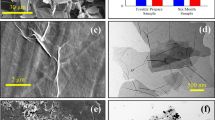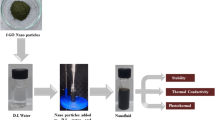Abstract
Advanced nanofluid with high stability is essential to meet the demands of the current industry and solar thermal systems. In industrial application, graphene oxide (GO) nanofluid formulated with ethylene glycol (EG)/water (W) is usually well-known for good stability along with high thermal conductivity. In this research, GO nanofluid is characterized for exploring its thermal, optical and suspension stability under certain conditions and then utilized as working fluid in photovoltaic thermal (PV/T) system for measuring its performance compared to those of water and Al2O3, TiO2 and hybrid Al2O3-TiO2-based nanofluids. The thermal conductivity, thermal stability, morphology and optical absorbance are characterized by using thermal analyzer, TGA, SEM and UV–vis analysis, respectively. The results revealed that the thermal conductivity of GO/EG:W nanofluid was increased by 9.5% at 40 °C compared to water. It also showed good stability with a zeta potential of 30.3 mV. The numerical implantation of GO/EG:W nanofluid performed by COMSOL Multiphysics software presented significant improvement compared to Al2O3/EG:W, TiO2/EG:W and TiO2-Al2O3/EG:W nanofluids with a concentration of 0.01 mass% to 0.1 mass%. The measured electrical and thermal efficiencies of the PV/T system were 13.5% and 76%, respectively, using GO/EG:W with 0.07 kg s−1 mass flow rate and 0.01 mass% concentration. The stated findings identified GO/EG:W nanofluid as more effective in enhancing PV/T system’s performance than other tested working fluids.







Similar content being viewed by others
Abbreviations
- EG:
-
Ethylene glycol
- PV:
-
Photovoltaic
- EDX:
-
Energy-dispersive x-ray
- PV/T:
-
Photovoltaic thermal
- FEA:
-
Finite element analysis
- SWCNT:
-
Single-walled carbon nanotube
- FESEM:
-
Field emission scanning electron microscopy
- TEM:
-
Transmission electron spectroscopy
- FF:
-
Fill factor
- TGA:
-
Thermogravimetric analysis
- GO:
-
Graphene oxide
- UV–vis:
-
Ultraviolet–visible spectroscopy
- GO/EG:W:
-
Graphene oxide/Ethylene Glycol: Water
- UDF:
-
User-defined functions
- I sc :
-
Short-circuit current
- V oc :
-
Open-circuit voltage
- MWCNT:
-
Multi-walled carbon nanotube
References
Tembhare S, Barai D, Bhanvase B. Performance evaluation of nanofluids in solar thermal and solar photovoltaic systems: a comprehensive review. Renew Sust Energ Rev. 2022;153:111738. https://doi.org/10.1016/j.rser.2021.111738.
Zaboli M, Ajarostaghi SSM, Saedodin S, Pour MS. Thermal performance enhancement using absorber tube with inner helical axial fins in a parabolic trough solar collector. Appl Sci. 2021;11:7423. https://doi.org/10.3390/app11167423.
Bhakre S, Sawarkar P, Kalamkar V. Performance evaluation of PV panel surfaces exposed to hydraulic cooling–a review. Sol Energy. 2021;224:1193–209. https://doi.org/10.1016/j.solener.2021.06.083.
Alshuraiaan B. Evaluation of the thermal performance of various nanofluids used to harvest solar energy. Energy Ecol Environ. 2021;6:531–9.
Saedodin S, Zaboli M, Ajarostaghi SSM. Hydrothermal analysis of heat transfer and thermal performance characteristics in a parabolic trough solar collector with turbulence-inducing elements. Sustain Energy Technol Assess. 2021;46:101266. https://doi.org/10.1016/j.seta.2021.101266.
Hossain F, Karim M, Bhuiyan A. A review on recent advancements of the usage of nano fluid in hybrid photovoltaic/thermal (PV/T) solar systems. Renew Energy. 2022;188:114–31. https://doi.org/10.1016/j.renene.2022.01.116.
Zaytseva O, Neumann G. Carbon nanomaterials: production, impact on plant development, agricultural and environmental applications. Chem Biol Technol Agric. 2016;3:17. https://doi.org/10.1186/s40538-016-0070-8.
Wahab A, Khan M, Hassan A. Impact of graphene nanofluid and phase change material on hybrid photovoltaic thermal system: exergy analysis. J Clean Prod. 2020;277:123370. https://doi.org/10.1016/j.jclepro.2020.123370.
Qeays I, Yahya S, Asjad M, Khan Z. Multi-performance optimization of nanofluid cooled hybrid photovoltaic thermal system using fuzzy integrated methodology. J Clean Prod. 2020;256:120451. https://doi.org/10.1016/j.jclepro.2020.120451.
Parsa S, Yazdani A, Aberoumand H, Farhadi Y, Ansari A, Aberoumand S, Karimi N, Afrand M, Cheraghian G, Ali H. A critical analysis on the energy and exergy performance of photovoltaic/thermal (PV/T) system: the role of nanofluids stability and synthesizing method. Sustain Energy Technol Assess. 2022;51:101887. https://doi.org/10.1016/j.seta.2021.101887.
Kim S, Choi S, Kim D. Thermal conductivity of metal-oxide nanofluids: particle size dependence and effect of laser irradiation. J Heat Transf. 2007;129:298–307.
Delouei A, Sajjadi H, Izadi M, Mohebbi R. The simultaneous effects of nanoparticles and ultrasonic vibration on inlet turbulent flow: an experimental study. Appl Therm Eng. 2019;146:268–77.
Abdallah S, Elsemary I, Altohamy A, Abdelrahman M, Attia A, Abdellatif O. Experimental investigation on the effect of using nano fluid (Al2O3-Water) on the performance of PV/T system. Therm Sci Eng Prog. 2018;7:1–7.
Yang L, Hu Y. Toward TiO2 nanofluids—part 1: preparation and properties. Nanoscale Res Lett. 2017;12:417. https://doi.org/10.1186/s11671-017-2184-8.
Kiliç F, Menlik T, Sözen A. Effect of titanium dioxide/water nanofluid use on thermal performance of the flat plate solar collector. Sol Energy. 2018;164:101–8.
Subramani J, Nagarajan P, Mahian O, Sathyamurthy R. Efficiency and heat transfer improvements in a parabolic trough solar collector using TiO2 nanofluids under turbulent flow regime. Renew Energy. 2018;119:19–31.
Kahani M, Zamen M, Rostami B. Modeling and empirical study of TiO2/water nanofluid flows in a modified configuration with new layer arrangement of a photovoltaic/thermal system. Sustain Energy Technol Assess. 2022;51:101932. https://doi.org/10.1016/j.seta.2021.101932.
Zaboli M, Ajarostaghi SSM, Saedodin S, Behnam K. Hybrid nanofluid flow and heat transfer in a parabolic trough solar collector with inner helical axial fins as turbulator. Eur Phys J Plus. 2021;136:841. https://doi.org/10.1140/epjp/s13360-021-01807-z.
Samylingam L, Aslfattahi N, Saidur R, Yahya S, Afzal A, Arifutzzaman A, Tan K, Kadirgama K. Thermal and energy performance improvement of hybrid PV/T system by using olein palm oil with MXene as a new class of heat transfer fluid. Solar Energy Mater Solar Cells. 2020;218:110754. https://doi.org/10.1016/j.solmat.2020.110754.
Yan S, Kalbasi R, Nguyen Q, Karimipour A. Rheological behavior of hybrid MWCNTs-TiO2/EG nanofluid: a comprehensive modeling and experimental study. J Mol Liq. 2020;308:113058.
Sangeetha M, Manigandan S, Ashok B, Brindhadevi K, Pugazhendhi A. Experimental investigation of nanofluid based photovoltaic thermal (PV/T) system for superior electrical efficiency and hydrogen production. Fuel. 2021;286:119422.
Venkatesh T, Manikandan S, Selvam C, Harish S. Performance enhancement of hybrid solar PV/T system with graphene based nanofluids. Int Commun Heat Mass Transfer. 2022;130:105794.
Shankara R, Banapurmath N, D’Souza A, Sajjan A, Ayachit N, Khan T, Badruddin I, Kamangar S. An insight into the performance of radiator system using ethylene glycol-water based graphene oxide nanofluids. Alex Eng J. 2022;61:5155–67. https://doi.org/10.1016/j.aej.2021.10.037.
Bahiraei M, Heshmatian S. Graphene family nanofluids: a critical review and future research directions. Energy Convers Manage. 2019;196:1222–56.
Chiam HW, Azmi WH, Usri NA, Mamat R, Adam NM. Thermal conductivity and viscosity of Al2O3 nanofluids for different based ratio of water and ethylene glycol mixture. Exp Thermal Fluid Sci. 2017;81:420–9. https://doi.org/10.1016/j.expthermflusci.2016.09.013.
Esfe MH, Razi P, Hajmohammad MH, Rostamian SH, Sarsam WS, Arani AAA, Dahari M. Optimization, modeling and accurate prediction of thermal conductivity and dynamic viscosity of stabilized ethylene glycol and water mixture Al2O3 nanofluids by NSGA-II using ANN. Int Commun Heat Mass Transfer. 2017;82:154–60.
Adun H, Kavaz D, Dagbasi M. Review of ternary hybrid nanofluid: synthesis, stability, thermophysical properties, heat transfer applications, and environmental effects. J Cleaner Prod. 2021;328:129525. https://doi.org/10.1016/j.jclepro.2021.129525.
Tiwari AK, Kumar V, Said Z, Paliwal HK. A review on the application of hybrid nanofluids for parabolic trough collector: recent progress and outlook. J Cleaner Prod. 2021;292:126031. https://doi.org/10.1016/j.jclepro.2021.126031.
Sandhya M, Ramasamy D, Sudhakar K, Kadirgama K, Samykano M, Harun WSW, Najafi G, Mofijur M, Mazlan M. A systematic review on graphene-based nanofluids application in renewable energy systems: preparation, characterization, and thermophysical properties. Sustain Energy Technol Assess. 2021;44:101058. https://doi.org/10.1016/j.seta.2021.101058.
Sati P, Shende RC, Ramaprabhu S. An experimental study on thermal conductivity enhancement of DI water-EG based ZnO(CuO)/graphene wrapped carbon nanotubes nanofluids. Thermochim Acta. 2018;666:75–81. https://doi.org/10.1016/j.tca.2018.06.008.
Sunil J, Vignesh J, Vettumperumal R, Maheswaran R, Raja RAA. The thermal properties of CaO-nanofluids. Vacuum. 2019;161:383–8. https://doi.org/10.1016/j.vacuum.2019.01.010.
Fazal MA, Rubaiee S. Progresses of PV cell technology: feasibility of building materials, cost, performance, and stability. Sol Energy. 2023;258:203–19. https://doi.org/10.1016/j.solener.2023.04.066.
Rubaiee S, Fazal MA. Efficiency enhancement of photovoltaic solar system by integrating multi-pipe copper frame filled with ZnO doped phase change material. MRS Energy Sustain. 2023. https://doi.org/10.1557/s43581-023-00063-1.
Rahman MM, Hasanuzzamana M, Rahim NA. Effects of operational conditions on the energy efficiency of Photovoltaic modules operating in Malaysia. J Clean Prod. 2017;143:912–24. https://doi.org/10.1016/j.jclepro.2016.12.029.
Nasrin R, Hasanuzzaman M, Rahim NA. Effect of nanofluids on heat transfer and cooling system of the photovoltaic/thermal performance. Int J Numer Method H. 2019;2019(29):1920–46. https://doi.org/10.1108/HFF-04-2018-0174.
Acknowledgements
This work was funded by the Deanship of Scientific Research (DSR), University of Jeddah, Jeddah (Grant No. UJ-02-004-ICGR). The authors gratefully acknowledge the technical and financial support of DSR.
Author information
Authors and Affiliations
Corresponding author
Additional information
Publisher's Note
Springer Nature remains neutral with regard to jurisdictional claims in published maps and institutional affiliations.
Rights and permissions
Springer Nature or its licensor (e.g. a society or other partner) holds exclusive rights to this article under a publishing agreement with the author(s) or other rightsholder(s); author self-archiving of the accepted manuscript version of this article is solely governed by the terms of such publishing agreement and applicable law.
About this article
Cite this article
Rubaiee, S., Yahya, S.M., Fazal, M.A. et al. Characterization of Al2O3, TiO2, hybrid Al2O3-TiO2 and graphene oxide nanofluids and their performance evaluations in photovoltaic thermal system. J Therm Anal Calorim 148, 11467–11477 (2023). https://doi.org/10.1007/s10973-023-12492-8
Received:
Accepted:
Published:
Issue Date:
DOI: https://doi.org/10.1007/s10973-023-12492-8




